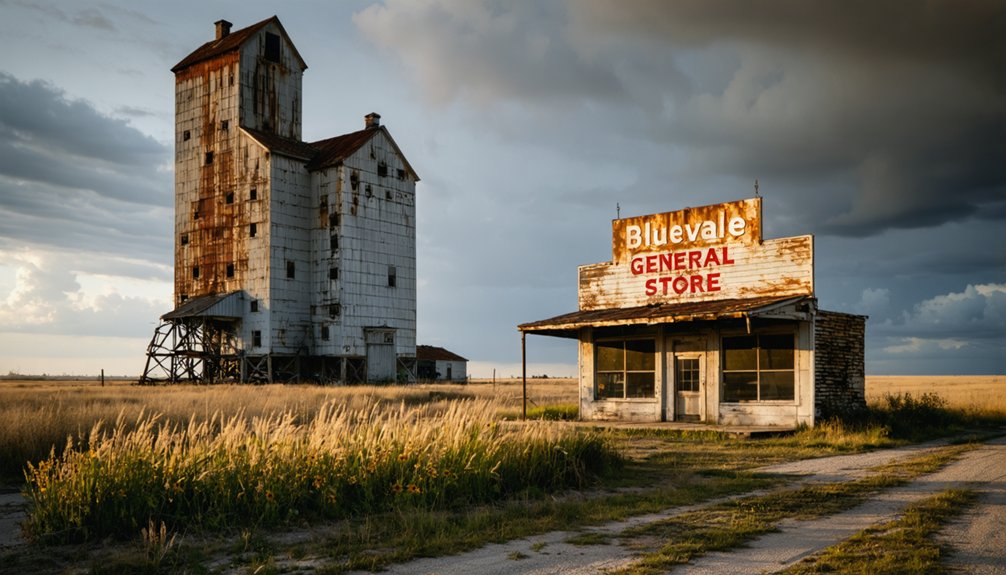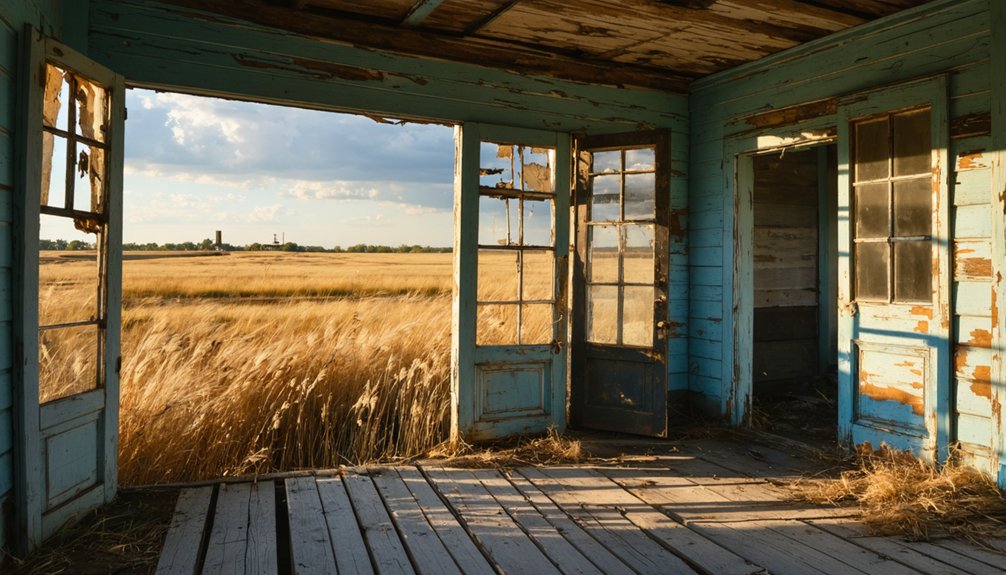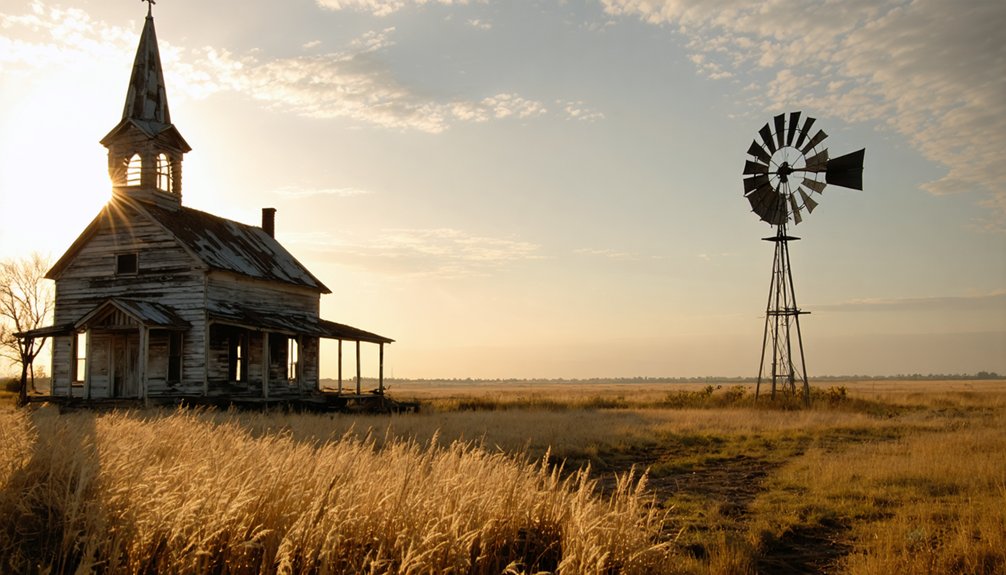You’ll find Bluevale in South Dakota’s Black Hills, where it sprang up during the 1874-1875 gold rush. The town flourished with mines, sawmills, and essential services including two churches, hotels, and a railroad stop. As mining operations struggled with rising costs and declining ore quality, Bluevale’s fortunes faded. After its post office closed in 1976, the town was abandoned, and by 1967 most buildings were demolished. Today, only slight land depressions hint at the stories buried beneath empty fields.
Key Takeaways
- Bluevale emerged in 1875 during the Black Hills gold rush, transitioning from placer mining to hard rock extraction by 1880.
- The town featured essential services including two churches, hotels, a school, post office, and banking facilities before its decline.
- Railroad access initially boosted Bluevale’s growth, but later service reductions contributed significantly to the town’s eventual abandonment.
- Most structures were demolished in 1967, with the post office closing in 1976, leaving only slight land depressions as evidence.
- Historical records, photographs, and artifacts are preserved by the South Dakota State Historical Society, documenting Bluevale’s mining town legacy.
The Rise of a Mining Town
While the Black Hills gold rush officially began with Custer’s 1874 expedition, the area that would become Bluevale emerged during the subsequent wave of prospecting activity in 1875.
You’d have found early miners working the creeks with basic placer mining techniques, using pans and sluice boxes to capture free gold from stream deposits.
Miners carried picks and shovels as their primary tools during these early days.
The Gordon Party stockade stood as evidence of the earliest illegal settlement attempts in the region.
As surface gold depleted, prospectors traced the placer deposits to their source, searching for the elusive “Mother Lode.”
This shift to hard rock mining brought more sophisticated operations to the region, similar to the nearby Homestake Mine discovery in 1876.
The change demanded new mining techniques, including mercury amalgamation for gold recovery.
You’ll recognize this period as essential to Bluevale’s development, when basic prospecting gave way to organized mining operations, drawing waves of fortune seekers to the Black Hills.
Daily Life in Early Bluevale
Life in early Bluevale extended far beyond the gold-seeking activities that brought people to the region. Family dynamics centered around modest wood-frame homes clustered together, while single miners found shelter in boarding houses that sometimes doubled as schools or mercantiles.
Your daily routines would’ve revolved around the mines, with supporting industries like sawmills keeping the town’s economy moving. Much like many towns that were seven miles apart, Bluevale emerged as a crucial stop along the railroad line. You’d have relied on the local mercantile for supplies, visited the post office for communication with the outside world, and conducted business at the town’s bank. Like the town of Tinton near Spearfish, the isolated location meant relying heavily on local resources and community support.
Three times a week, you’d hear the stagecoach arriving with news and goods. While medical care was basic and challenges were plenty, you’d find comfort in community gatherings at the church, school events, and informal social activities with neighbors.
Mining Operations and Economic Growth
As gold discoveries near Deadwood and Custer sparked the Black Hills mining boom in 1874-1875, Bluevale’s mining operations emerged alongside numerous small claims in the region.
Mining techniques evolved from surface placer mining to hard rock extraction by 1880, with the adoption of cyanide processing by 1899 improving gold recovery rates from complex ores. Two distinct ore types were processed: blue and red ore, with the oxidized red ore being more amenable to cyanide treatment.
Early miners panned gold from streams, but later dug deep shafts and used cyanide to extract more precious metal from stubborn rock.
The economic impact of mining transformed Bluevale and surrounding areas. You’d have seen dozens of workers at operations like the Portland mine, while freight and transport activities flourished as ore shipments moved by rail.
However, like many Black Hills ventures, Bluevale’s mines struggled with rising costs and declining ore quality. Despite early prosperity, most local operations couldn’t maintain profitability into the 1900s, leaving only the mighty Homestake Mine to endure until 2002.
Transportation and Trade Routes
Before railroads revolutionized the region, transportation to and from Bluevale relied heavily on Concord stagecoaches and ox-drawn freight wagons traversing the rugged Black Hills terrain.
You’d find “bull trains” of ten ox teams hauling supplies along 200-mile routes from Fort Pierre, taking a month for a round trip on rutted trails.
Transportation methods evolved when the Chicago & North Western railroad reached the area, transforming trade dynamics for mining communities like Bluevale.
Like many former mining camps, these early communities faced various challenges that ultimately led to their abandonment and ghost town status.
Similar to the Deadwood Trail routes from 1876, these vital supply lines were essential for transporting goods and supporting the growth of frontier settlements.
The rail system’s efficiency replaced the dangerous stagecoach routes through Red Canyon, which had been abandoned by 1878 due to Indian hostilities.
While the railroad brought prosperity to junction points like Elrod, it also meant that when rail lines were eventually rerouted or ceased operations, towns dependent on them often couldn’t survive.
Community Buildings and Services
Bluevale’s bustling community revolved around several key buildings that served its peak population of 300 residents in the early 1900s.
You’d find strong civic infrastructure with two churches – Methodist and Catholic – alongside a community hall where locals gathered for shows, plays, and meetings. The town’s commitment to community engagement showed in its newspaper office, schoolhouse, and public bath house. Many travelers photographed the abandoned buildings for their haunting atmosphere.
You could’ve handled your banking at the local branch, stayed at one of two hotels including the famous Kappa Hotel, or visited various stores and cafes. Like many South Dakota towns, the community saw significant decline during the Great Depression years, which devastated the local economy.
The post office, operating from 1907 to 1976, kept you connected to the outside world. For essential services, you’d find a blacksmith, gas station, and a grain elevator supporting the town’s agricultural needs.
Notable Residents and Stories
While many frontier towns claimed colorful characters, Bluevale’s residents were primarily hardworking miners, railroad workers, and their families who shaped the town’s identity in the early 1900s. Notable figures included families who ran boarding houses and mercantiles, providing essential services to the mining community.
The town’s community folklore was enriched by its connection to nearby Terry, where Calamity Jane spent her final days before being moved to Deadwood for burial. Life in Bluevale was marked by both triumph and tragedy, as evidenced by the heartbreaking loss of a mother and two children to the 1919 influenza outbreak.
The town’s residents weathered frequent floods and economic changes, adapting to shifting demands as the post office relocated multiple times to serve the evolving population.
The Town’s Gradual Decline

The harsh realities of economic dependency began to shape Bluevale’s fate in the early 1920s, as mining operations near the town steadily lost their productivity.
You’d have witnessed the cascading effects as railroad services dwindled, cutting off essential transportation links that once connected Bluevale to larger markets.
Economic challenges intensified when local businesses, including sawmills and mercantiles, shuttered their doors.
Population shifts followed as younger residents sought opportunities elsewhere, leaving behind aging infrastructure and diminishing services.
The town’s post office changed locations several times before closing, while the school faced consolidation due to shrinking enrollment.
Flooding events damaged what remained of the town’s buildings and roads, while nature slowly reclaimed abandoned railroad grades.
Bluevale’s transformation from thriving community to ghost town status unfolded gradually, marking the end of an era.
Remnants and Ruins Today
Standing structures at Bluevale’s original townsite are virtually non-existent today, following a systematic demolition effort in 1967 that removed most remaining buildings.
You’ll find the site has largely reverted to empty fields and pastureland, with natural vegetation obscuring most archaeological traces of the former settlement. Like many ghost town sites, the area has returned to its natural state with minimal evidence of past habitation.
If you’re searching for industrial remnants from Bluevale’s mining era, you won’t find much – unlike other Black Hills ghost towns that still showcase mine shafts, ore bins, and mill foundations.
The site lacks historical markers or interpretive signs to guide visitors, and any remaining foundations or cellar pits are difficult to locate.
What was once a bustling Black Hills community has become an indistinct ghost site, with only slight land depressions hinting at its past existence.
Preserving Bluevale’s Legacy

You’ll find detailed historical records and artifacts from Bluevale carefully preserved in the South Dakota State Historical Society’s archives, providing essential documentation of the town’s rise and fall.
Local preservation groups have installed protective fencing and interpretive signage around remaining structures while actively monitoring the site to prevent vandalism and unauthorized access.
Through extensive photographic surveys and oral histories collected from former residents’ descendants, you can trace how this once-bustling mining community has transformed over time, keeping its memory alive for future generations.
Historical Records Matter Today
While ghost towns often fade into obscurity, Bluevale’s legacy endures through meticulously preserved historical records that illuminate daily life in this former South Dakota settlement.
You’ll find these records’ historical significance extends far beyond mere documentation, offering tangible connections to the town’s vibrant past.
Today’s digital tools and archival access have transformed how you can explore Bluevale’s history:
- Search online databases containing digitized maps, photos, and property records
- Access GIS-integrated spatial data showing historical landscape changes
- View restored photographs revealing daily life and architectural details
- Explore oral histories and newspaper archives through library collections
These preserved records don’t just tell Bluevale’s story – they empower you to actively engage with the town’s heritage through research, education, and community events that keep its spirit alive.
Physical Site Protection Efforts
The ongoing protection of Bluevale’s physical remains represents a complex partnership between private landowners, state agencies, and preservation organizations.
Site management strategies at Bluevale follow established South Dakota preservation protocols, including access control through fencing and “No Trespassing” signs. You’ll find these measures help prevent vandalism while protecting both visitors and fragile structures.
The state’s preservation office works directly with property owners to implement effective protection methods, from structural stabilization to surveillance systems.
Preservation strategies often tap into funding sources like the Deadwood Fund Grant and federal tax incentives, making it financially feasible to maintain historic integrity.
When you visit, you’ll notice how these coordinated efforts help safeguard Bluevale’s remaining structures while allowing controlled access for those interested in exploring South Dakota’s heritage.
Community Memory Through Photography
Since Bluevale’s decline in the early 20th century, photography has served as an essential medium for preserving the town’s visual legacy. Through photographic preservation efforts, you’ll find detailed documentation of architectural remnants, from towering grain elevators to weathered church steeples, capturing the essence of this South Dakota settlement before time takes its toll.
Visual storytelling brings Bluevale’s history to life through:
- Archival collections showing the town’s establishment and growth phases
- Comparative imagery revealing changes in the landscape over decades
- Documentation of remaining structures by local photographers
- Digital preservation projects making photos globally accessible
These images now serve as vital links to Bluevale’s past, enabling you to witness the town’s transformation while supporting educational initiatives and maintaining community connections for future generations.
Frequently Asked Questions
Are There Any Documented Supernatural Occurrences or Ghost Stories From Bluevale?
Among 80+ documented ghost towns in South Dakota, you won’t find any verified ghost sightings or haunted locations in Bluevale’s records. Historical documents focus on its industrial decline rather than supernatural occurrences.
What Was the Average Temperature and Climate Conditions in Bluevale?
You’ll find average climate marked by broad temperature fluctuations, with summer highs reaching 86°F, winter lows dropping to 13°F, and modest annual rainfall of 18.5 inches plus 28 inches of snow.
Were There Any Major Crimes or Lawlessness Issues Reported?
Like many frontier towns, you’ll find no records of major crimes. While scattered disputes over mining claims occurred, crime rates remained low, and minimal law enforcement was needed beyond local community oversight.
Did Native American Tribes Have Any Significant Interactions With Bluevale?
You’ll find limited evidence of Native relations in historical records, though Sioux tribes traversed this area. Cultural exchanges likely occurred as the town sat between traditional Lakota territories and settlements.
What Natural Disasters or Epidemics Affected the Town’s Population?
When the chips were down, you’d have faced flooding events that isolated the community, while disease outbreaks, including the 1919 influenza epidemic, struck neighboring towns hard.
References
- https://www.sdpb.org/arts-life/vanished-south-dakota-in-the-moment
- https://www.youtube.com/watch?v=Glucs_Rq8Xs
- https://www.sdpb.org/rural-life-and-history/2023-08-21/some-black-hills-ghost-towns-and-their-origins
- https://www.sdhspress.com/journal/south-dakota-history-2-2/some-black-hills-ghost-towns-and-their-origins/vol-02-no-2-some-black-hills-ghost-towns-and-their-origins.pdf
- https://www.youtube.com/watch?v=_0WNYsFLSLA
- https://icatchshadows.com/okaton-and-cottonwood-a-photographic-visit-to-two-south-dakota-ghost-towns/
- https://en.wikipedia.org/wiki/List_of_ghost_towns_in_South_Dakota
- https://b1027.com/south-dakota-has-an-abundance-of-ghost-towns/
- https://blackhillsvisitor.com/learn/spokane/
- https://www.onlyinyourstate.com/experiences/south-dakota/capa-ghost-town-sd



